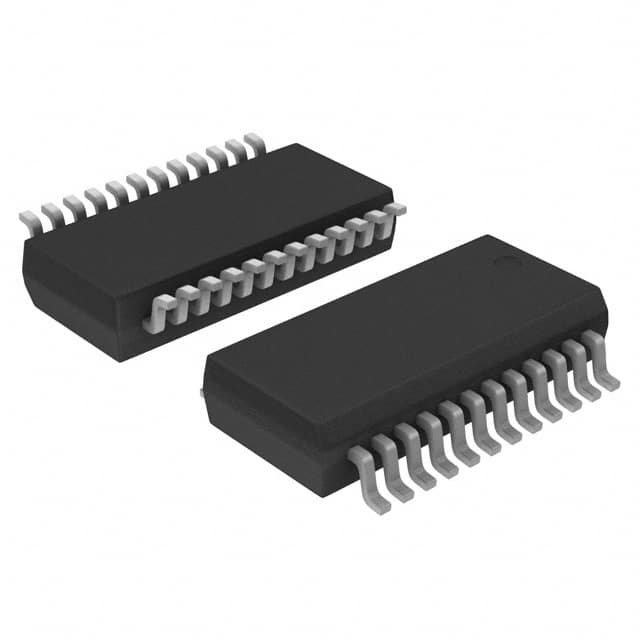MAX7318AAG+T
Product Overview
- Category: Integrated Circuit (IC)
- Use: Digital I/O Expander
- Characteristics: High-performance, low-power, 16-bit I/O expander with interrupt output
- Package: 24-pin SSOP (Shrink Small Outline Package)
- Essence: The MAX7318AAG+T is a versatile digital I/O expander that provides additional input/output pins for microcontrollers or other digital devices.
- Packaging/Quantity: Available in tape and reel packaging, with 2500 units per reel.
Specifications
- Supply Voltage Range: 2.3V to 5.5V
- Number of I/O Pins: 16
- Maximum Output Current per Pin: ±25mA
- Operating Temperature Range: -40°C to +85°C
- Communication Interface: I²C-compatible serial interface
- Interrupt Output: Open-drain active-low interrupt output
Detailed Pin Configuration
The MAX7318AAG+T has a total of 24 pins, which are assigned as follows:
- SDA: Serial Data Input/Output
- SCL: Serial Clock Input
- INT: Interrupt Output 4-19. P0-P15: General Purpose I/O Pins
- GND: Ground
- VDD: Supply Voltage
- A0: Address Input Bit 0
- A1: Address Input Bit 1
- RESET: Active-Low Reset Input
Functional Features
- Expandable I/O: The MAX7318AAG+T provides 16 additional I/O pins, allowing for increased connectivity and flexibility in system design.
- Interrupt Capability: The interrupt output pin (INT) can be configured to generate an interrupt signal to the microcontroller when a specific event occurs on any of the I/O pins.
- Low Power Consumption: The device operates in a low-power mode, consuming minimal power when not actively driving the I/O pins.
- Addressable: The address inputs (A0 and A1) allow for multiple devices to be connected on the same I²C bus, expanding the number of available I/O pins even further.
Advantages and Disadvantages
Advantages: - Provides additional I/O pins without requiring extra microcontroller pins - Interrupt capability enhances system responsiveness - Low power consumption extends battery life in portable applications - Addressable feature allows for scalability in system design
Disadvantages: - Limited maximum output current per pin may restrict certain high-current applications - Requires I²C communication interface support from the microcontroller
Working Principles
The MAX7318AAG+T functions as a digital I/O expander by utilizing the I²C serial interface to communicate with the microcontroller. It acts as an intermediary between the microcontroller and external devices, providing additional input/output pins. The device can be configured to operate in different modes, such as input or output, and can generate interrupts based on specific events detected on the I/O pins.
Detailed Application Field Plans
The MAX7318AAG+T finds applications in various fields, including but not limited to:
- Industrial Automation: Used to expand the number of I/O pins in control systems, allowing for increased connectivity with sensors, actuators, and other peripheral devices.
- Home Automation: Enables the integration of additional sensors, switches, and indicators into smart home systems, enhancing functionality and user experience.
- Automotive Electronics: Provides extra I/O pins for automotive control units, facilitating the connection of various components and subsystems.
- Internet of Things (IoT): Supports the expansion of I/O capabilities in IoT devices, enabling seamless integration with other devices and cloud platforms.
Detailed and Complete Alternative Models
- MCP23017: 16-bit I/O expander with similar features and I²C interface.
- PCF8574: 8-bit I/O expander with I²C interface, suitable for applications requiring fewer I/O pins.
- SX1509: 16-channel I/O expander with advanced features such as LED driver control and keypad scanning.
These alternative models offer similar functionality to the MAX7318AAG+T and can be considered based on specific application requirements.
Word count: 533 words
Lista 10 Vanliga frågor och svar relaterade till tillämpningen av MAX7318AAG+T i tekniska lösningar
Sure! Here are 10 common questions and answers related to the application of MAX7318AAG+T in technical solutions:
Q: What is the MAX7318AAG+T? A: The MAX7318AAG+T is a serial-interfaced peripheral that provides 16 I/O ports, which can be used for various applications.
Q: What is the maximum voltage that can be applied to the MAX7318AAG+T? A: The MAX7318AAG+T can handle a maximum voltage of 5.5V.
Q: How can I communicate with the MAX7318AAG+T? A: The MAX7318AAG+T uses an I2C interface for communication with a microcontroller or other devices.
Q: Can I use the MAX7318AAG+T to control LEDs? A: Yes, the MAX7318AAG+T can be used to control LEDs by providing current sinking capability on its I/O ports.
Q: What is the maximum current that can be sunk by each I/O port of the MAX7318AAG+T? A: Each I/O port of the MAX7318AAG+T can sink up to 25mA of current.
Q: Can I use the MAX7318AAG+T to drive motors or high-power devices? A: No, the MAX7318AAG+T is not designed to drive motors or high-power devices. It is best suited for low-power applications like LEDs.
Q: Can I connect multiple MAX7318AAG+T devices together? A: Yes, multiple MAX7318AAG+T devices can be connected together using their I2C interfaces to expand the number of available I/O ports.
Q: What is the maximum frequency at which I can communicate with the MAX7318AAG+T? A: The MAX7318AAG+T supports communication speeds up to 400kHz.
Q: Can I use the MAX7318AAG+T in battery-powered applications? A: Yes, the low power consumption of the MAX7318AAG+T makes it suitable for battery-powered applications.
Q: Are there any evaluation boards or development kits available for the MAX7318AAG+T? A: Yes, Maxim Integrated provides evaluation kits and development boards that can be used to prototype and test applications using the MAX7318AAG+T.
Please note that these answers are general and may vary depending on the specific requirements and use cases. It's always recommended to refer to the datasheet and application notes provided by the manufacturer for detailed information.


